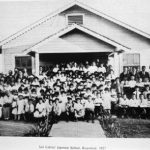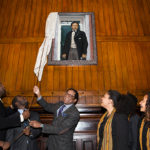Youth CommentaryBy Pha Lo, Pacific News Service A 23-year-old Hmong writer who has been the key bridge for her mother and father to contemporary California life wants first to avoid guilt by association as she reads headlines on the Wisconsin hunting tragedy. Upon deeper reflection, she finds insights to share from her mediator role.
December 2, 2004 – As a child born in America to Hmong immigrants, the role of mediator between my elders and the things they discovered here fell heavily upon me. Lately, as I read of a Hmong man accused of shooting and killing Caucasian deer hunters in Wisconsin, I feel the bridges I have built over a lifetime to connect a past world to this one crumbling under national scrutiny. When I was a child, I would have to remind my grandmothers to pick up the telephone receiver before dialing. They would forget and first push numbers confidently, then wonder why they heard only a dial tone when they lifted the receiver to their ears. It was my generation, born into the world of telephones, raised by those who lived in a world without, who mustered the patience to teach these things one day at a time. When I learned that Chai Soua Vang, a Hmong refugee from Laos, had been arrested in connection with a Wisconsin shooting that left six dead and two wounded, my immediate reaction was to disassociate myself. “One drop in the basket can taint the batch,” Hmong say, because in the old country, rodents often crawled into wicker baskets and left droppings that, no matter how small, spread unwanted odors to soil entire batches of clean rice. I denounce unconditionally the acts of violence with which Mr. Vang stands accused. But in light of his alleged motives, I have come to claim a collective responsibility. If he wandered illegally onto private property and in fact was met with racial taunts, as he claims, then this tragedy is a metaphor for gaps in communication I still do not know how to bridge. With our reasons for being in America not always understood, being Hmong here meant that I was always wandering into private spaces, uninvited. It has been nearly 30 years since my parents came from Laos as refugees, and still they work to find a valid place in America. My father was a soldier with the Special Guerilla Units (SGU), recruited and trained by the CIA to fight inside Laos during the Vietnam War. His role was to guard part of the Ho Chi Minh trail and to fight encroaching North Vietnamese forces. A grenade attack in 1968 left shrapnel in both his legs. Five years later, Laos fell to Communism, and many Hmong feared their direct ties to America would make them targets for retaliation. Thousands evacuated, and some were eventually resettled to the United States. Assimilation in America has been difficult because the world from which Hmong come is drastically different, and the conditions that brought them here, abrupt. When I was in middle school, I warned my father not to fish in certain places. He was angered and confused by rules of licensing and legal versus illegal catches. “You call this the land of freedom, but I am not free to fish where I please,” he said. He reminded me that he had, after all, fought alongside Americans who promised relocation to the “land of freedom” if the war was lost. As a boy, my father had picked up a bamboo fishing rod and caught anything he pleased, from any river he wished. That defined for him what it meant to be truly “free.” In the end, we wound up buying fish from the market. My father fished only occasionally, where permitted. My mother is a gardener who uses only grass for fertilizer. She would oftentimes take my sister and me to the parking lots of private businesses where we would gather piles of fresh lawn clippings into trash bags. We later learned about private property, and eventually bought a lawn mower to clip our own grass. But I remained sorry because we could no longer gather enough grass to fertilize the whole garden. Mediating between cultures meant more than simply conveying rules and regulations or translating a set of English words into Hmong. It meant explaining to Caucasian neighbors — some of whom were inclined to say, “Go back to your own country” — that we had not come for economic gain, but as refugees from a war lost in partnership with America. Last year, 15,000 Hmong refugees from the Wat Thamkrobrak campgrounds north of Bangkok, Thailand, were approved for resettlement to America. Many have joined relatives in cities such as Fresno, Calif., and St. Paul, Minn., where there are sizable Hmong populations. With more expected over the next year, they too will need a bridge between worlds. At first, I tried to separate myself from Mr. Vang, an attempt to avoid guilt by ethnic association. When his ethnicity grabbed the national spotlight, I feared that attempts made to understand the Hmong would, under the circumstances, unfairly taint my people. Today, I am more afraid that, if there is any truth behind a “cultural clash” as a partial explanation for this tragedy, the bridge my generation tried to build is not resilient enough. If that is true, if I have failed in my role as mediator, I hope to learn and do better — both for the new Hmong refugees and for my Caucasian neighbors.
PNS contributor Pha Lo traveled to Asia in 2003 to research Hmong refugees. |
||
|










